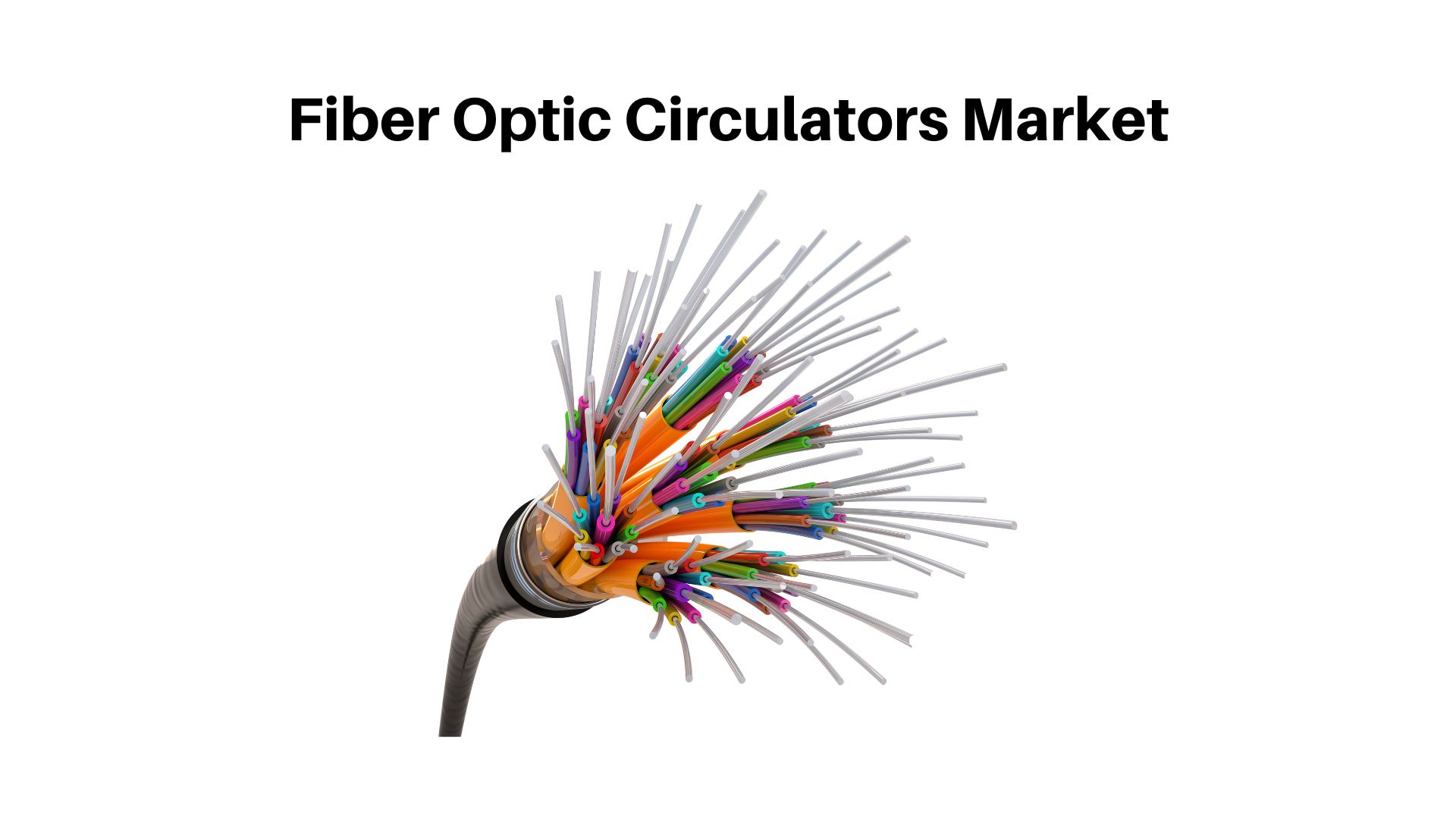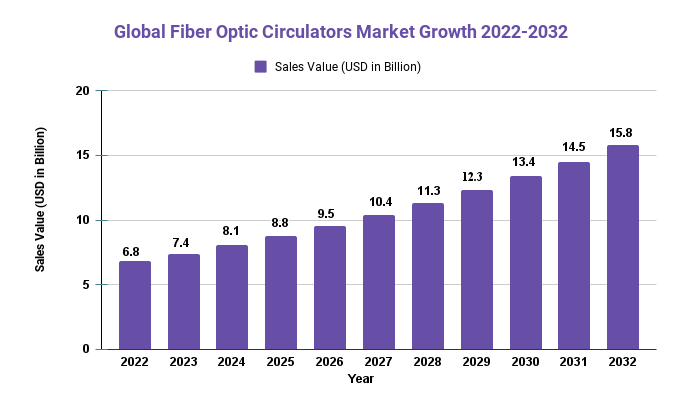Fiber Optic Circulators Market Size to Hit Around ( USD 15.8 Billion by 2032 ) + CAGR of 8.8%

Page Contents
Market Overview
Published Via 11Press: Fiber optic circulators are non-reciprocal devices that transmit light from one port to another in a unidirectional fashion, commonly used in optical communication, sensor systems, and test equipment. The global fiber optic circulators market is expected to expand significantly over the coming years due to rising demand for high-speed data communication systems, rising adoption of fiber optic communication systems, and rising bandwidth-intensive applications.
The global fiber optic circulators market size is forecast to reach USD 15.8 billion by 2032 from USD 6.8 billion in 2022, rising at a compound annual growth rate (CAGR) of 8.8% during the forecast period.
North America is expected to dominate the fiber optic circulators market due to the presence of major companies and the growing demand for fiber optic communication systems across various industries. Furthermore, the Asia Pacific region is projected to experience considerable growth in this space as emerging economies such as China and India increasingly adopt fiber optic technology.
The fiber optic circulators market is highly competitive, featuring several global and regional players. Thorlabs Inc., Gould Fiber Optics, OZ Optics Limited, EXFO Inc., Finisar Corporation, and Molex LLC are some of the leading companies operating within this space. These firms are working hard to develop advanced fiber optic circulators to meet growing demands from various end-user industries.

Key Takeaways
- The global fiber optic circulators market is expected to experience substantial growth over the coming years due to an increasing need for high-speed data communication, rising adoption of fiber optic communication systems, and rising demands for bandwidth-intensive applications.
- North America is expected to hold a dominant share in the fiber optic circulators market due to the presence of major companies and the growing demand for fiber optic communication systems across various industries.
- The Asia Pacific region is expected to experience rapid growth in the market due to the increased adoption of fiber optic technology among emerging economies such as China and India.
- The fiber optic circulators market is highly competitive, featuring several global and regional players.
- Thorlabs, Inc., Gould Fiber Optics, OZ Optics Limited, EXFO Inc., Finisar Corporation, and Molex LLC are key players in this market.
- These companies are working to develop cutting-edge fiber optic circulators in order to meet the increasing demand from various end-user industries.
Request For Sample Report: https://market.us/report/fiber-optic-circulators-market/request-sample/
Regional Snapshot
- North America: North America is expected to hold a significant share of the fiber optic circulator market due to the presence of major companies and the increasing demand for fiber optic communication systems across various industries. The United States is currently the leading market for these circulators in North America.
- Europe: Europe is a major market for fiber optic circulators, with countries such as Germany, France, and the United Kingdom driving growth in this area. The increasing demand for high-speed internet and the increasing adoption of fiber optic communication systems across various industries are fueling market expansion in this region.
- Asia Pacific: The Asia Pacific region is expected to experience significant growth in the fiber optic circulators market due to the rising adoption of this technology among emerging economies such as China and India. The increasing need for high-speed data communication, rising investments in telecom infrastructure, and growing application of fiber optic technology across various industries are driving market development within this region.
- Middle East and Africa: The Middle East and Africa region has experienced significant growth in the fiber optic circulators market due to the increasing adoption of fiber optic communication systems within telecommunications services.
- Latin America: Latin America has a relatively small market for fiber optic circulators, but it is expected to experience significant growth over the coming years due to the increasing adoption of fiber optic technology across various industries and increased investments in telecom infrastructure. Brazil is currently the leading supplier of these circulators within Latin America.
Drivers
- Increased Demand for High-Speed Data Communication: With the increasing need for faster data transfers, fiber optic communication systems are becoming more and more popular, which in turn is fueling demand for fiber optic circulators.
- Rising Adoption of Fiber Optic Communication Systems: Fiber optic communication systems are becoming more widely adopted across various industries, such as telecommunications, healthcare, and aerospace – driving the growth of the fiber optic circulators market.
- Growing Demand for Bandwidth-Intensive Applications: With the rising use of bandwidth-intensive applications such as video streaming, cloud computing, and online gaming, there is an increasing need for high-speed internet connectivity – driving demand for fiber optic circulators.
- Advancements in Fiber Optic Technology: With the continuous advancements in fiber optic technology, the performance of fiber optic circulators is improving, which is fueling their demand across a variety of applications.
Governments and telecom service providers are investing heavily in telecom infrastructure, including fiber optic communication systems, to meet the increasing demand for high-speed internet connectivity – this in turn is propelling growth in the fiber optic circulators market.
Restraints
- High installation costs: The initial cost of installing fiber optic communication systems and associated components such as fiber optic circulators is relatively high, which may discourage small and medium-sized enterprises from adopting these systems.
- Limited availability of skilled professionals: The installation and maintenance of fiber optic communication systems and associated components such as fiber optic circulators require skilled professionals, whose availability is limited in some regions, which may hinder the growth of the market.
- Issues related to signal loss: Fiber optic communication systems may suffer from signal loss due to factors such as bend losses and splicing losses, which may affect the performance of fiber optic circulators and reduce their effectiveness.
- Competition from other technologies: Although fiber optic communication systems offer many advantages over traditional copper-based systems, they face competition from other emerging technologies such as wireless communication and satellite communication.
- Political and economic instability in some regions: Political and economic instability in some regions may affect the growth of the fiber optic circulators market by discouraging investments in telecom infrastructure and delaying the adoption of fiber optic communication systems.
Opportunities
- Increased Demand for Fiber Optic Communication Systems in Emerging Economies: As emerging economies such as China, India, and Brazil adopt fiber optic communication systems at an increasing rate, there are significant growth prospects for the fiber optic circulator market.
- Rise in Demand for Data Centers: The growing need for data centers to support cloud computing and other applications has driven up demand for fiber optic communication systems, creating opportunities in the fiber optic circulators market.
- Advances in 5G Technology: The deployment of 5G networks necessitates the use of fiber optic communication systems, leading to an increase in demand for fiber optic circulators – particularly in regions where 5G deployment is taking place.
- Increased Investments in Smart City Projects: Governments and private organizations are making significant investments into smart city initiatives that require the deployment of fiber optic communication systems, creating opportunities for manufacturers in the fiber optic circulators market.
- Growth in the aerospace and defense sector: This sector is experiencing remarkable expansion, which is driving demand for fiber optic communication systems as well as associated components like fiber optic circulators.
Challenges
- Limited range of applications: Fiber optic circulators are primarily used in fiber optic communication systems, which limits their range of applications and may limit their growth potential.
- Complex installation and maintenance: The installation and maintenance of fiber optic communication systems and associated components such as fiber optic circulators can be complex and require skilled professionals, which may limit their adoption by small and medium-sized enterprises.
- Environmental challenges: Fiber optic communication systems and associated components such as fiber optic circulators may be affected by environmental factors such as temperature, humidity, and electromagnetic interference, which may affect their performance.
- Intense competition: The fiber optic circulator market is highly competitive, with many established players and new entrants competing for market share, which may limit the growth potential for some players.
- Uncertainty in regulations: Regulations related to fiber optic communication systems and associated components such as fiber optic circulators may change rapidly, which may create uncertainty for market players and hinder their growth.
Grow your profit margin with Market.us Get this Report
Recent Developments
- On February 20, 2021, Menara Networks – a leader in optical transport solutions – unveiled their new plug-and-play circulator module designed for use with coherent optical transmission systems.
- Senko Advanced Components, a leader in fiber optic connectivity solutions, recently unveiled their 1310nm polarization-maintaining fiber optic circulator that is ideal for use in high-speed communication systems.
- Lightel Technologies, a leader in fiber optic equipment manufacturing, recently unveiled its broadband circulator device. This versatile device operates over an expansive wavelength range and can be applied to telecommunications, sensing, and medical applications alike.
- Corning Incorporated, a leader in optical fiber and cable solutions, recently unveiled an expansion to their selection of wavelength-selective switches and optical circulators that will propel the growth of high-speed fiber optic communication networks.
- Diamond SA, a leader in precision connectors and optical components, recently unveiled its high-frequency circulators designed for demanding power applications. These circulators can be utilized in satellite communication systems, radar applications, as well as other environments.
Key Market Segments
Type
- 3 – Ports
- 4 – Ports
- More than 4 – Ports (> 4 – Ports)
Application
- Telecommunications
- Private Data Networks
- Cable TV
- Military/ Aerospace
Key Market Players
- Ascentta Inc
- Aviation Magneto Optical Sensor Corporation (AMOS)
- Boston Applied Technologies Incorporated (BATi)
- Clearfield Inc. Comcore Technologies Inc Corning
- Crowntech Photonics
- DK Photonics Technology Limited
- DK Photonics Technology Limited
- Fiberlake Technology Co. Ltd (Shenzhen)
- Intepon Co. Ltd
- Kamaxoptic communication Co. Ltd. (KOC Group)
- KINSOM Technology Limited
- Lightel Technologies Inc.
Report Scope
| Report Attribute | Details |
| The market size value in 2022 | USD 6.8 Bn |
| Revenue forecast by 2032 | USD 15.8 Bn |
| Growth Rate | CAGR Of 8.8% |
| Regions Covered | North America, Europe, Asia Pacific, Latin America, and Middle East & Africa, and the Rest of the World |
| Historical Years | 2017-2022 |
| Base Year | 2022 |
| Estimated Year | 2023 |
| Short-Term Projection Year | 2028 |
| Long-Term Projected Year | 2032 |
Frequently Asked Questions
Q: What is a Fiber Optic Circulator?
A: A fiber optic circulator is an electronic device that directs light signals in one direction within a fiber optic communication system. It's composed of three ports that enable light to pass from one port to another in either a clockwise or counterclockwise rotation.
Q: What are the applications of fiber optic circulators?
A: Fiber optic circulators are primarily employed in fiber optic communication systems for signal routing, amplification, and isolation. They're also found in sensing applications, medical devices, and scientific instruments.
Q: What are the advantages of fiber optic circulators?
A: Fiber optic circulators offer low insertion loss, high isolation, and polarization-dependent loss. Furthermore, they're compact, lightweight, and highly durable – perfect for small spaces!
Q: What are the different types of fiber optic circulators?
A: Generally speaking, two main types are polarization-independent circulators (PICs) and polarization-maintaining circulators (PMCs). PICs can be used in applications where polarization isn't an issue, while PMCs must be utilized when polarization accuracy is crucial.
Q: What is driving the growth of the fiber optic circulator market?
A: The fiber optic circulators market is being propelled forward by increasing adoption of fiber optic communication systems, rising demand for data centers, advances in 5G technology, increasing investments in smart city projects, and expansion within aerospace and defense.
Q: Who are the key players in the fiber optic circulator market?
A: Companies such as Corning Incorporated, Menara Networks, Senko Advanced Components, Lightel Technologies, Diamond SA, Thorlabs Inc., OZ Optics, and Timbercon Inc. are some of the key players within this space.
The team behind market.us, marketresearch.biz, market.biz and more. Our purpose is to keep our customers ahead of the game with regard to the markets. They may fluctuate up or down, but we will help you to stay ahead of the curve in these market fluctuations. Our consistent growth and ability to deliver in-depth analyses and market insight has engaged genuine market players. They have faith in us to offer the data and information they require to make balanced and decisive marketing decisions.



